詳細介紹JavaScript二元樹及各種遍歷演演算法
2022-07-27 18:01:57

【相關推薦:、】
什麼是二元樹
二元樹是每個節點最多隻能有兩個子節點的樹,如下圖所示:

一個二元樹具有以下幾個特質:
- 第
i層的節點最有隻有2^(i-1)個; - 如果這顆二元樹的深度為
k,那二元樹最多有2^k-1個節點; - 在一個非空的二元樹中,若使用
n0表示葉子節點的個數,n2是度為2的非葉子節點的個數,那麼兩者滿足關係n0 = n2 + 1。
滿二元樹
如果在一個二元樹中,除了葉子節點,其餘的節點的每個度都是2,則說明該二元樹是一個滿二元樹,
如下圖所示:
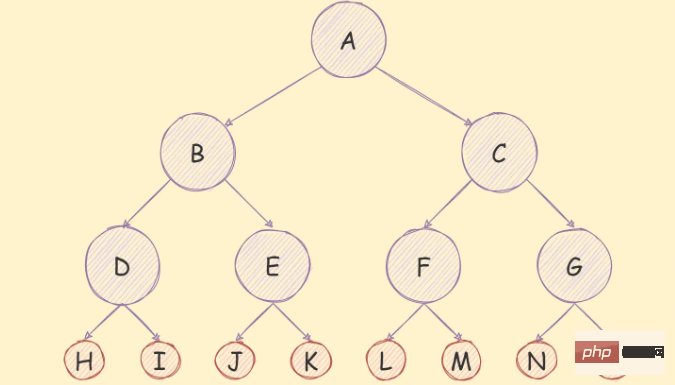
滿二元樹除了滿足普通二元樹特質,還具有如下幾個特質:
- 滿二元樹的的第
n層具有2^(n-1)個節點; - 深度為
k的滿二元樹一定存在2^k-1個節點,葉子節點的個數為2^(k-1); - 具有
n個節點的滿二元樹的深度為log_2^(n+1)。
完全二元樹
如果一個二元樹去掉最後一次層是滿二元樹,且最後一次的節點是依次從左到右分佈的,則這個二元樹是一個完全二元樹,
如下圖所示:
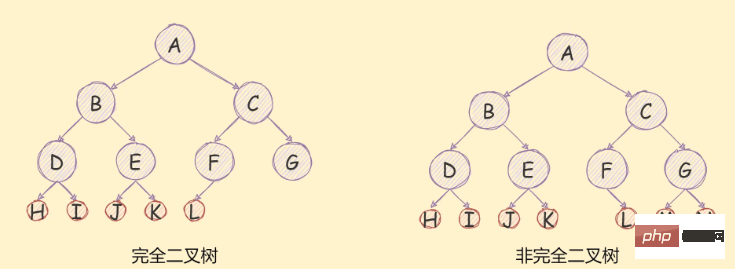
二元樹的儲存
儲存二元樹的常見方式分為兩種,一種是使用陣列儲存,另一種使用連結串列儲存。
陣列儲存
使用陣列儲存二元樹,如果遇到完全二元樹,儲存順序從上到下,從左到右,如下圖所示:

如果是一個非完全二元樹,如下圖所示:
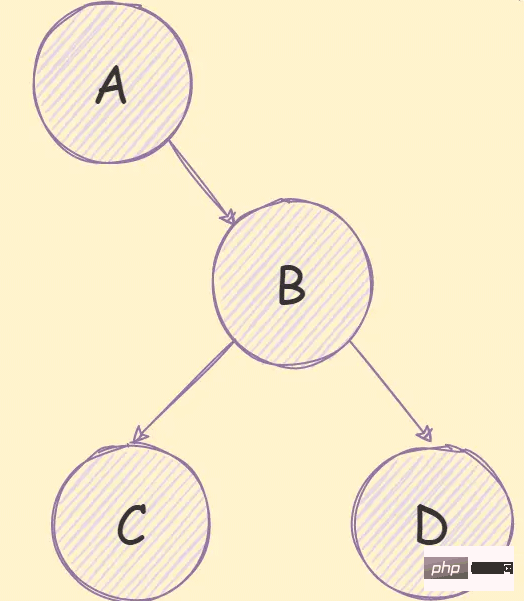
需要先將其轉換為完全二元樹,然後在進行儲存,如下圖所示:
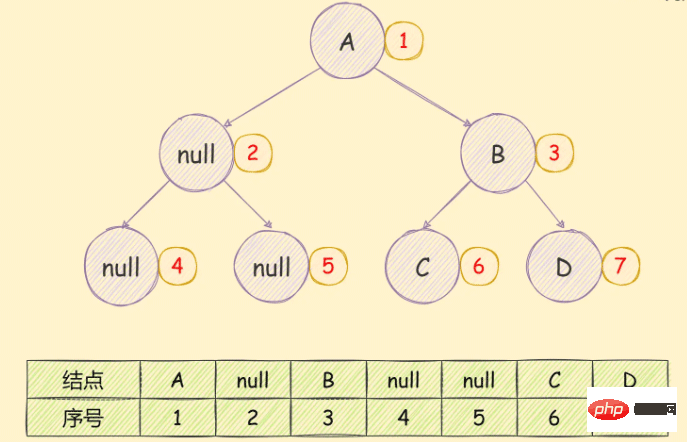
可以很明顯的看到儲存空間的浪費。
連結串列儲存
使用連結串列儲存通常將二元樹中的分為3個部分,如下圖:

這三個部分依次是左子樹的參照,該節點包含的資料,右子樹的參照,儲存方式如下圖所示:
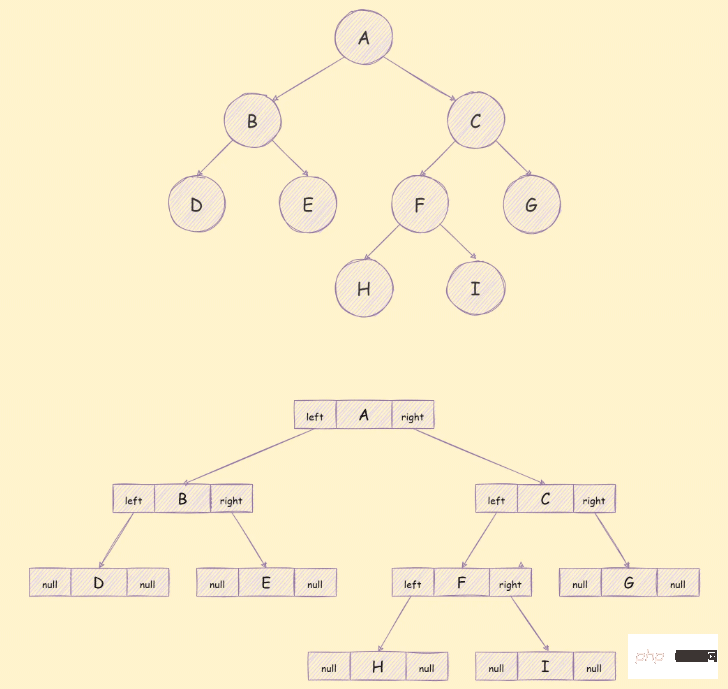
與二元樹相關的演演算法
以下演演算法中遍歷用到的樹如下:
// tree.js
const bt = {
val: 'A',
left: {
val: 'B',
left: { val: 'D', left: null, right: null },
right: { val: 'E', left: null, right: null },
},
right: {
val: 'C',
left: {
val: 'F',
left: { val: 'H', left: null, right: null },
right: { val: 'I', left: null, right: null },
},
right: { val: 'G', left: null, right: null },
},
}
module.exports = bt深度優先遍歷
二元樹的深度優先遍歷與樹的深度優先遍歷思路一致,思路如下:
- 存取根節點;
- 存取根節點的
left - 存取根節點的
right - 重複執行第二三步
實現程式碼如下:
const bt = {
val: 'A',
left: {
val: 'B',
left: { val: 'D', left: null, right: null },
right: { val: 'E', left: null, right: null },
},
right: {
val: 'C',
left: {
val: 'F',
left: { val: 'H', left: null, right: null },
right: { val: 'I', left: null, right: null },
},
right: { val: 'G', left: null, right: null },
},
}
function dfs(root) {
if (!root) return
console.log(root.val)
root.left && dfs(root.left)
root.right && dfs(root.right)
}
dfs(bt)
/** 結果
A B D E C F H I G
*/廣度優先遍歷
實現思路如下:
- 建立佇列,把根節點入隊
- 把對頭出隊並存取
- 把隊頭的
left和right依次入隊 - 重複執行2、3步,直到佇列為空
實現程式碼如下:
function bfs(root) {
if (!root) return
const queue = [root]
while (queue.length) {
const node = queue.shift()
console.log(node.val)
node.left && queue.push(node.left)
node.right && queue.push(node.right)
}
}
bfs(bt)
/** 結果
A B C D E F G H I
*/先序遍歷
二元樹的先序遍歷實現思想如下:
- 存取根節點;
- 對當前節點的左子樹進行先序遍歷;
- 對當前節點的右子樹進行先序遍歷;
如下圖所示:

遞迴方式實現如下:
const bt = require('./tree')
function preorder(root) {
if (!root) return
console.log(root.val)
preorder(root.left)
preorder(root.right)
}
preorder(bt)
/** 結果
A B D E C F H I G
*/迭代方式實現如下:
// 非遞迴版
function preorder(root) {
if (!root) return
// 定義一個棧,用於儲存資料
const stack = [root]
while (stack.length) {
const node = stack.pop()
console.log(node.val)
/* 由於棧存在先入後出的特性,所以需要先入右子樹才能保證先出左子樹 */
node.right && stack.push(node.right)
node.left && stack.push(node.left)
}
}
preorder(bt)
/** 結果
A B D E C F H I G
*/中序遍歷
二元樹的中序遍歷實現思想如下:
- 對當前節點的左子樹進行中序遍歷;
- 存取根節點;
- 對當前節點的右子樹進行中序遍歷;
如下圖所示:
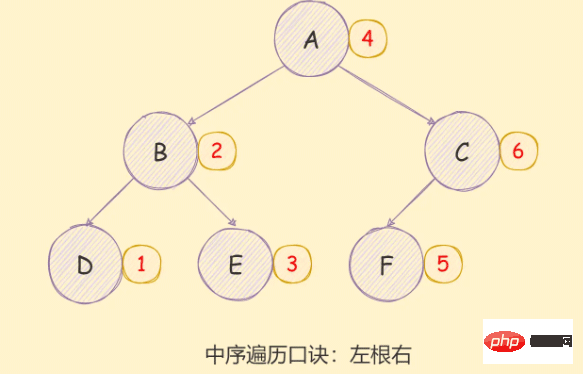
遞迴方式實現如下:
const bt = require('./tree')
// 遞迴版
function inorder(root) {
if (!root) return
inorder(root.left)
console.log(root.val)
inorder(root.right)
}
inorder(bt)
/** 結果
D B E A H F I C G
*/迭代方式實現如下:
// 非遞迴版
function inorder(root) {
if (!root) return
const stack = []
// 定義一個指標
let p = root
// 如果棧中有資料或者p不是null,則繼續遍歷
while (stack.length || p) {
// 如果p存在則一致將p入棧並移動指標
while (p) {
// 將 p 入棧,並以移動指標
stack.push(p)
p = p.left
}
const node = stack.pop()
console.log(node.val)
p = node.right
}
}
inorder(bt)
/** 結果
D B E A H F I C G
*/後序遍歷
二元樹的後序遍歷實現思想如下:
- 對當前節點的左子樹進行後序遍歷;
- 對當前節點的右子樹進行後序遍歷;
- 存取根節點;
如下圖所示:
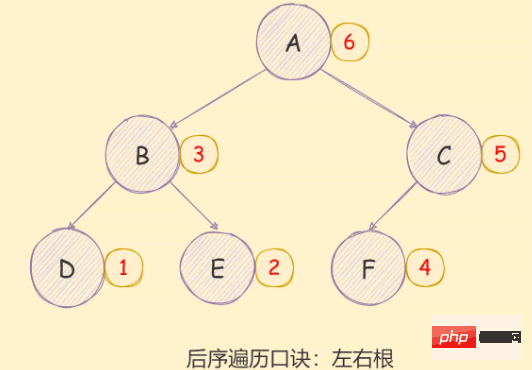
遞迴方式實現如下:
const bt = require('./tree')
// 遞迴版
function postorder(root) {
if (!root) return
postorder(root.left)
postorder(root.right)
console.log(root.val)
}
postorder(bt)
/** 結果
D E B H I F G C A
*/迭代方式實現如下:
// 非遞迴版
function postorder(root) {
if (!root) return
const outputStack = []
const stack = [root]
while (stack.length) {
const node = stack.pop()
outputStack.push(node)
// 這裡先入left需要保證left後出,在stack中後出,就是在outputStack棧中先出
node.left && stack.push(node.left)
node.right && stack.push(node.right)
}
while (outputStack.length) {
const node = outputStack.pop()
console.log(node.val)
}
}
postorder(bt)
/** 結果
D E B H I F G C A
*/【相關推薦:、】
以上就是詳細介紹JavaScript二元樹及各種遍歷演演算法的詳細內容,更多請關注TW511.COM其它相關文章!
